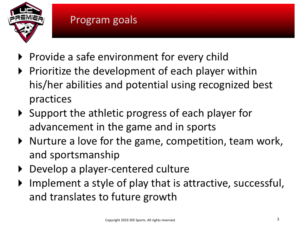As part of fleshing out the curriculum for the UC Premier 7v7 and 9v9 age groups, I had to think carefully about the fundamental principles associated with player development and the desired outcomes. I put together the following two slides to outline the highest level goals and non-goals that we want to express to our players, parents, and staff:
I’ve found that by defining underlying principles, the ability to make decisions in the moment is simplified. If a choice matches our goals and does not violate our non-goals, that it is likely that is the right option. Likewise, if a decision violates our goals, then it should be discarded.
Providing a safe environment
As caretakers for children, their safety has to be our highest priority, always. Safety refers to physical safety – protection from physical harm – and also mental safety. Physical safety involves the obvious – making sure no child is left on the field after practice, etc – but also the development of the physical, tactical, and technical elements that allow the players to engage in safe practices within the game. On the topic of mental safety, it must be noted that children are highly malleable and are responsive to a different set of cues than adults. This does not mean that we should prevent our players from failure. The nature of the game – and life – is a series of successes and failures. Learning to accept and learn from failure, identify solutions, moving forward are essential aspects of the environment that we value. It is also vital that we identify and develop the social rules and positive culture within the group – so that all players are good teammates within the team and to each other.
Prioritize player development using recognized best practices
An environment in which players are provided with opportunities (“affordances” per Chow, Davids, Button, & Renshaw, 2016) for learning and are given the tools and ideas to solve problems provides a bridge to the game in which the players must react to oppositional and time pressures without constant interactions with the coach. An extensive amount of research has gone into the game, teaching techniques (pedagogy), athletic development, and child development over the last several decades. It is important that we are willing to challenge long-held beliefs where there are conflicts with current understandings of player development.
Support the athletic progress of each player
When entering the 7v7 age group, many of our players are still in the process of building the athletic base and movement skills that will be required for them to be successful in sports. It is crucial that we recognize that the 7v7 and 9v9 age groups are an essential stepping stone in the maturation process. It is also important to understand that not every athlete in our programs will choose soccer as their primary sport. Development of each player’s athletic abilities, support for multisport athletes, and consideration of the physiological differences within age groups are all important elements of our statement of goals.
Nurture a love of the game, competition, teamwork, and sportsmanship
Of these, only the love of the game is soccer-specific. As a soccer club, we are hopeful that our players will develop a long-lasting love for our sport that will make it desirable for continuing in sports. Competition, teamwork, and sportsmanship are more fundamental to the development of the young men and women that we hope will graduate through our program. It is important that our club represents well in outside competitions – that we work hard, that we support each other, and that we respect the opponents, referees, and the game. These characteristics are also desirable within the training environment. As teachers, it is our responsibility to define a culture which places a priority on the development of competition, teamwork, and sportsmanship.
Development of a player-centered culture
Placing the player at the focal point of our development environment clarifies our approach. There are several organizations that have identified initiatives associated with player-centered coaching (c.f., US Club Soccer, 2019; TOVO Institute, 2019; Positive Coaching Alliance, 2019). Focus on the player and her needs (rather than us as staff or coaches and our needs) helps to identify appropriate decisions.
A style of play that is attractive, successful, and translates to future growth
It is intentional that the last of our goals specifically relates to the execution of the game. An attractive style implies enjoyment – for the players, fans, and coaches. A successful style is one in which there are victories – both in the context of wins and losses but also in the application of our training ideas into games. Future growth is a statement that we will play the game in a manner that develops our players for the larger game at older age groups. Implicit is a need to develop soccer-specific skills and athleticism – relying on all four dimensions of player attributes (technical, tactical, physical, and psychological) rather than just one or two. In short, we are developing complete players
Non-goals
The non-goals listed above are self-explanatory and can be summarized as the opposite of the goals. Stating the non-goals explicitly helps to reflect the undesirable behaviors.
Summary
It is certainly possible to list additional goals or non-goals, shuffle priorities, or reword the listed goals for more specificity or generality. It is likely that over time, we will revise our list as experiences demonstrate gaps in the list.
For now, this feels like a great place to start a conversation – with ourselves, our parents, and our players – and to develop program elements that are aligned to a common high-level philosophy.
References
Chow, J. Y., Davids, K., Button, C., & Renshaw, I. (2016). Nonlinear pedagogy in skill acquisition. An Introduction. NY Routledge.
Positive Coaching Alliance (2019). Positive Coaching Alliance. Positivecoach.org. Retrieved from https://www.positivecoach.org/
TOVO Institute. (2019). TOVO Institute – Journey To Extraordinary – TOVO Institute. TOVO Institute. Retrieved from https://tovoinstitute.com/
US Club Soccer. (2019). Players First Licensing. Usclubsoccer.org. Retrieved from https://www.usclubsoccer.org/players-first-licensing

